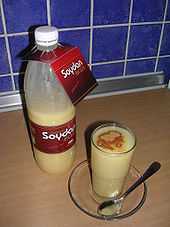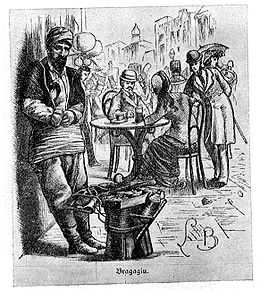Boza

Boza, also bosa (from Turkish: boza [1][2]), is a popular fermented beverage in Kazakhstan, Turkey, Kyrgyzstan, Albania, Bulgaria, Macedonia, Montenegro, Bosnia and Herzegovina, parts of Romania, Serbia, Ukraine. It is a malt drink, made from maize (corn) and wheat in Albania, fermented wheat in Turkey and wheat or millet in Bulgaria and Romania. It has a thick consistency and a low alcohol content (usually around 1%), and has a slightly acidic sweet flavor.
There are different types of boza, with the most prominent of them being Bulgarian, Albanian and Turkish Boza.
History

Fermented cereal flour -generally millet- drinks have been produced by native Anatolians and Mesopotamians since the 9th or 8th millennia BC and Xenophon mentioned in the 4th century BC how the locals preserved and cooled the preparations in earthen pots that were buried.[3] There are references mentioning boza-like "fermented (ground) millet drink" in Akkadian and Sumerian texts; the beverage is said to be respectively arsikku and ar-zig.[4] It wasn't until the 10th century that the drink was coined Boza and begun to be a common drink amongst Central Asian Turkic peoples. Later on, it spread to the Caucasus and the Balkans. It enjoyed its golden age under the Ottomans, and boza making became one of the principal trades in towns and cities from the early Ottoman period.
Until the 16th century, boza was drunk freely everywhere, but the custom of making the so-called Tartar boza laced with opium brought the wrath of the authorities down on the drink, and it was prohibited by sultan Selim II (1566–1574). He describes a type of non-alcoholic sweet boza of a milk white color made for the most part by Albanians.
In the 17th century, Sultan Mehmed IV (1648–1687) prohibited alcoholic drinks, in which category he included boza, and closed down all the boza shops. This prohibition would be reinforced and then loosened several times throughout the history of the empire. The 17th century Turkish traveler Evliya Çelebi reports that boza was widely drunk at this time, and that there were 300 boza shops employing over a thousand people in Istanbul alone.
At this period boza was widely drunk by the Janissaries in the army. Boza contained only a low level of alcohol, so as long as it was not consumed in sufficient quantities to cause drunkenness, it was tolerated on the grounds that it was a warming and strengthening beverage for soldiers. As Evliya Çelebi explained in the first volume ("Istanbul") of his Seyahatname (Travelogues), "These boza makers are numerous in the army. To drink sufficient boza to cause intoxication is sinful but, unlike wine, in small quantities it is not condemned."[5] In the 19th century, the sweet and non-alcoholic boza preferred at the Ottoman palace became increasingly popular, while the sour and alcoholic type of boza went out of style. In 1876, brothers Haci Ibrahim and Haci Sadik established a boza shop in the Istanbul district of Vefa, close to the then center of entertainment, Direklerarası. This boza, with its thick consistency and tart flavor, became famous throughout the city, and is the only boza shop dating from that period still in business today. The firm is now run by Haci Sadik and Haci Ibrahim's great-great-grandchildren.
Regional versions
Turkey
In Turkey it is served with cinnamon and roasted chickpeas (Leblebi in Turkish), and is consumed mainly in the winter months. The Ottoman Empire was known to feed its army with boza as it is rich in carbohydrates and vitamins.
"Vefa" shop, located in the Istanbul district of Vefa, is now a minor tourist attraction. Ömür Bozacısı of Bursa, Karakedi Bozacısı of Eskişehir, Akman Boza Salonu of Ankara and Soydan of Pazarcık, Bilecik are less famous but well known other vendors in Turkey. Vefa boza, as it is known, is made only from hulled millet, which is boiled in water and then poured into broad shallow pans; when cool the mixture is sieved, and water and sugar added.
Albania
Boza in Albania is made of maize (corn) and wheat flour, sugar and water. It has a sweet to sour taste. It differs from the other types: it is lighter and usually consumed as a refreshing drink in summer.
The most famous Albanian boza brand name is the Pacara Boza,[6] produced and sold by Kujtim Pacara in Kukes,Albania and Shyqyri Pacara in Tirana, Albania. It has a long tradition of being produced in Albania.
In Albania it is mostly produced and sold in the northern part of Albania; you can easily find it in the candy and ice-creams stores of the capital, Tirana.
Bulgaria
In Bulgaria it is part of the traditional "Banitsa with Boza" breakfast. Although a popular beverage, boza is used to describe something (film, piece of music, etc.) to be bland, boring, and of low quality. This comes from the turbid consistency and colour of Bulgarian boza. Also frequently used as pejorative is "thin (diluted) boza". Most brands of Boza in Bulgaria are currently sweetened with Aspartame and other artificial sweeteners. Good boza of high quaility is sweetened with raw cane sugar and it has genuine taste of boza. Before 1989, there was only natural, unsweetened boza. Now for decreased price and longer shelf life, most boza is artificially sweetened.
Macedonia
In the Republic of Macedonia boza is much thinner and lighter, and tastes sweeter.
The most famous boza shop in Macedonia is "Apche", located in Debar Maalo area, near the Universal Hall in Skopje also on Bit bazaar Cair on John Kenedy street .[7] The shop was founded by Isman Kadri in 1934. People called him Apche (the pill), jokingly claiming that his boza is a cure for all ills. He renamed the shop in 1940.[8] Other famous boza hotspots in Skopje are "Palma" and "Sheherezada." Besides ethnic Albanians, boza-making tradition is also present among ethnic Macedonians. One of the characters in the 1928 play Lence Kumanovce/Begalka (Lenche of Kumanovo, AKA Eloped Bride) by Vasil Iljoski is Trendo, the boza-vendor.[9]
Romania

The variant found in Romania is called bragă (from Russian: брага, "braga"[10]). It is sweeter than in Turkey and Bulgaria, but thicker and darker than in Republic of Macedonia.
Bragă may also include dry kvass, hops and sugar. It is prepared by drawing the raw grain material, mixing the must with sugar syrup, and then fermenting it with more hops. Bragă is an opaque beige or light brown liquid that to some may taste like beer. At a temperature of 20°C, bragă will keep for at least five days.
Serbia
In Serbia, boza is produced and sold in "oriental-type" confectioneries and health food stores. It is usually made of water, wheat flour, maize flour, yeast and sugar.
Other countries
In the United States commercial production of boza started in Skokie, Illinois in January 2009.
In Kyrgyzstan the wheat variety is widely available from street side vendors, mostly in the summer months. It is best known by the brand name "Shoro" but is also sold by Tan and others. It is frequently mixed with a Kefir-like sour milk drink to produce a slightly lighter and sharper tasting version.
Production and storage
Boza is produced in the Balkans and most of the Turkic regions, but not always using millet. The flavour varies according to the cereal which is used. In a scientific study of boza carried out by the Turkish Science and Technology Institute for Vefa Bozacisi, the drink was found to be extremely healthy and nourishing. One litre of boza contains a thousand calories, four types of vitamins A and B, and vitamin E. During fermentation lactic acid, which is contained by few foods, is formed, and this facilitates digestion.[6]
As boza spoils if not kept in a cool place, boza fermenters in Turkey (traditionally) don't sell boza in summer months and sell alternative beverages such as grape juice or lemonade. However, it is now available in summer time due to demand and availability of refrigeration. In Bulgaria, Albania and Macedonia, however, boza is produced as refreshing beverage year-round.
Trivia
Boza has been alleged to have an ability to enlarge women's breasts.[11] It is also recommended to women during their lactation period soon after they give birth as boza stimulates the production of milk.[6]
Similar beverages
Other beverages from around the world that are traditionally low-alcohol and lacto-fermented include:
See also
- Turkish cuisine
- Bosnian cuisine
- Macedonian cuisine
- Bulgarian cuisine
- Albanian cuisine
- Lithuanian cuisine
References
- ↑ "bosa." Webster's Third New International Dictionary, Unabridged. Merriam-Webster. 2002.
- ↑ "bosa." Oxford English Dictionary. 2nd edition. 1989.
- ↑ "Science against microbial pathogens: communicating current research and technological advances : Bacteriocin producing lactic acid bacteria isolated from Boza, a traditional fermented beverage from Balkan Peninsula – from isolation to application" by Jean Guy LeBlanc and Svetoslav Dimitrov Todorov, 2011, link: http://www.formatex.info/microbiology3/book/1311-1320.pdf
- ↑ page 20 of Hungarian-Mesopotamian dictionary by prof. Alfred Toth, Mikes international, 2007 http://www.federatio.org/mi_bibl/AlfredToth_Mesopotamian.pdf
- ↑ Evliya Çelebi; Şinasi Tekin; Gönül Alpay-Tekin; Fahir İz, Topkapı Sarayı Müzesi. Kütüphane (1989). Evliya Çelebi seyahatnamesi. Harvard Üniversitesi Basımevi.
- ↑ 6.0 6.1 6.2 Pacara Boza, Original Albanian Boza
- ↑ И по Апче ќе има добра боза (Good boza production will continue after Apche's death). Dnevnik, 24 December 2005, Retrieved 9 April 2007.
- ↑ Три урбани легенди: Апче, Карпош и Кенан (Three urban legends: Apche, Karposh, and Kenan). Forum, 2 December 2005, Retrieved 9 April 2007.
- ↑ Ви текнува ли: На уличните продавачи на боза (Do you remember: the street boza-vendors). Vest, 6 June 2005, Retrieved 9 April 2007.
- ↑ (Romanian) "Bragă". dexonline.ro.
- ↑ Breast beer sells like hot cakes. news.com.au, Retrieved 15 January 2007.
External links
![]() Media related to Boza at Wikimedia Commons
Media related to Boza at Wikimedia Commons